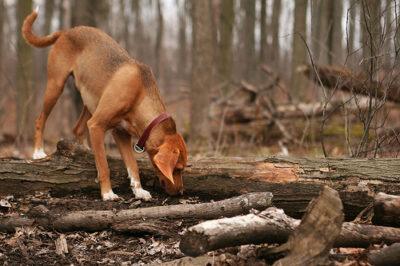
Image source: so-man-places.com
Taking your dog with you on excursions into the great outdoors can be a memorable experience. However, it can also quickly turn into a nightmare without adequate plans and preparation. There’s nothing quite like having enthusiastic companionship that is tailor-made for the outdoors.
The Many Benefits of the Wilderness Canine
Dogs can serve a variety of purposes when accompanying you on a hiking or camping getaway. First of all, they make great companions. Their enthusiasm for the great outdoors may well out-distance your own — and you won’t catch them complaining. Instead, they’ll be an extra motivator with their non-stop energy and curiosity when your own determination is flagging.
Secondly, dogs provide an added level of protection. They will sense a visitor with their keen hearing and powerful noses long before you do. If you watch your dog, you will see his demeanor change to reflect the approaching being. If it’s friendly (like another hiker), chances are he will be excited and wagging his tail. If it’s an unknown visitor or of questionable safety (like a wild animal), your dog may bark, stand stiff and tall or even step in front of you to shield you with his body. Whether your dog merely alerts you to a new arrival or takes on an aggressive position when danger approaches, this extra level of protection can be invaluable in the wilderness.
Finally, while dogs can serve more roles than the ones mentioned here, perhaps the most significant benefit can be their added muscle. Many dogs can carry a canine backpack comfortably or help pull a sled [1], wheeled cart or travois (a sled fashioned from sticks, originally used by North American Indians), an especially adaptable sled for the great outdoors. Care must be taken to condition the dog to the extra exertion of pulling or carrying extra weight, but many dogs take to this cheerfully and can be quite the asset.
Fitness and Health Preparations
When it comes to dogs, they are practically ready to go anytime, anywhere. However, if you are embarking on a longer trip or traveling to an area populated by ticks or other dangerous insects, it is a good idea to talk with your dog’s veterinarian prior to the trip. Make an appointment a month or more in advance. If your dog has not received the Lyme vaccine recently and you will be in an area known to house ticks, ask your vet about the vaccine. Also, ask about the dangers of heartworm and other internal parasites. Southern states tend to have more of an issue with these, but your vet will know best how to advise you.
Learn The Secrets Of A Veteran Hunter As He Demonstrates How To Quickly Field-Dress Game [2]
It’s also good to have your dog receive a general physical exam to check that he’s ready for the extra stress of an outdoor adventure. If your dog is older or mostly inactive, ask your vet about pain medicines that you can give should your pet become sore on the trip. Many of these medicines can have a sedative affect, so be sure to explain what you’re planning so you can get the non-drowsy type. If your trip is going to be particularly arduous or there is a potential for falls, ask your vet or one of the nurses to show you how to set a broken bone or support a sprain. It might seem like an extra hassle now, but if you need the knowledge on the trail, it will be priceless. Once your pet is cleared for the trip, take some time, preferably at least a month in advance, to help your dog work out. Take him on conditioning walks and jogs. This will make the trip much more enjoyable for both of you.
Training

Image source: SpotOnPetcare
The wilderness is an unpredictable place and it is important to have a dog that listens to you. Not only does this help with keeping you in the good graces of other wilderness explorers, it also can save your pet from an emergency veterinarian visit (to pull porcupine quills out of an overly inquisitive snout, for example) and may even save his life. Either take time to train your pet the following commands or brush up on them: “come,” “lie down,” “whoa (freeze),” “leave it/drop it,” “okay!” and “hurry-up/go potty.” While other commands can be useful depending on circumstances, the above list should get you off to a great start. Make sure your pet can also walk politely on a leash even if you plan on allowing him freedom most of the time. You never know when you might need to tether him, and it can be a nightmare to have a pulling and jumping canine on the other end of the leash.
Equipment
Your dog will need some of his own equipment, but you should be able to travel fairly light if you wish. If your dog is a candidate for backpacking, he may be able to carry all of his own gear depending on the length of your excursion. Food and water are important. While letting your pet drink from streams and ponds may seem easiest, be sure to check if the water in the area is clean. More than one pet has come home from a camping trip sick due to drinking the water. Consider taking water with you or at least using a filter bottle for your pet’s water. Bring two leashes and collars (in case one set breaks). Make sure your dog has his up-to-date license and rabies tags. If you should get separated, this can lead to a better outcome for him. You can also talk with your dog’s vet about implanting a microchip. Microchips have reunited many lost pets with their owners.
Make sure you have plenty of any medication your pet is taking as well as a few first aid supplies, including bandages and gauze, a disinfectant, Gatorade or Pedialyte (if the weather is hot), antibiotic ointment and Benadryl (handy if he gets bitten or has an allergic reaction to something). All of these items would be beneficial to have in your own personal first aid kit, so feel free to pack them together.
You will also want to consider bringing a blanket or bed for your pet if you won’t be sharing your sleeping bag. After a long day, your pet will be glad to curl up in comfort. Bring a pet lifejacket if you will be on the water and booties if you are going out in winter weather, as your dog’s feet may need to be protected from sharp ice or from freezing if they get wet. If you have a thinner coated dog and the weather will be cool, bring a dog coat along for him as well. Last, but not least, bring plastic bags to clean up after your pet anywhere where humans frequent (trails, campsites, etc.).
Following the above guidelines can get you off to a great start when it comes to involving your pet in your wilderness experience. In the end, you will both benefit as you make some great memories!
Do you have any other tips? Leave your reply in the section below:
Get $600 Worth Of Survival Blueprints … Absolutely Free! [3]
